Advanced Management Accounting Report: ABC Ltd Expansion Strategy
VerifiedAdded on 2021/02/20
|20
|5781
|68
Report
AI Summary
This report provides a comprehensive analysis of management accounting principles, focusing on the case of ABC Ltd., a small to medium-sized enterprise (SME) planning international expansion. It begins by examining the purpose of financial information for various stakeholders, including internal stakeholders like employees and the management board, and external stakeholders such as investors and creditors. The report then delves into the development of financial statements for planning and decision-making, including budgeting, capital assessment, and risk assessment. It critically evaluates financial information, acknowledging its limitations while highlighting its strategic value. The report further explores microeconomic accounting techniques like cost analysis, cost-volume-profit analysis, and cost variances. Finally, it examines the impact of internal and external factors on management accounting, including change management and recommendations for adapting to these changes. The conclusion summarizes the key findings and emphasizes the importance of management accounting in strategic decision-making.
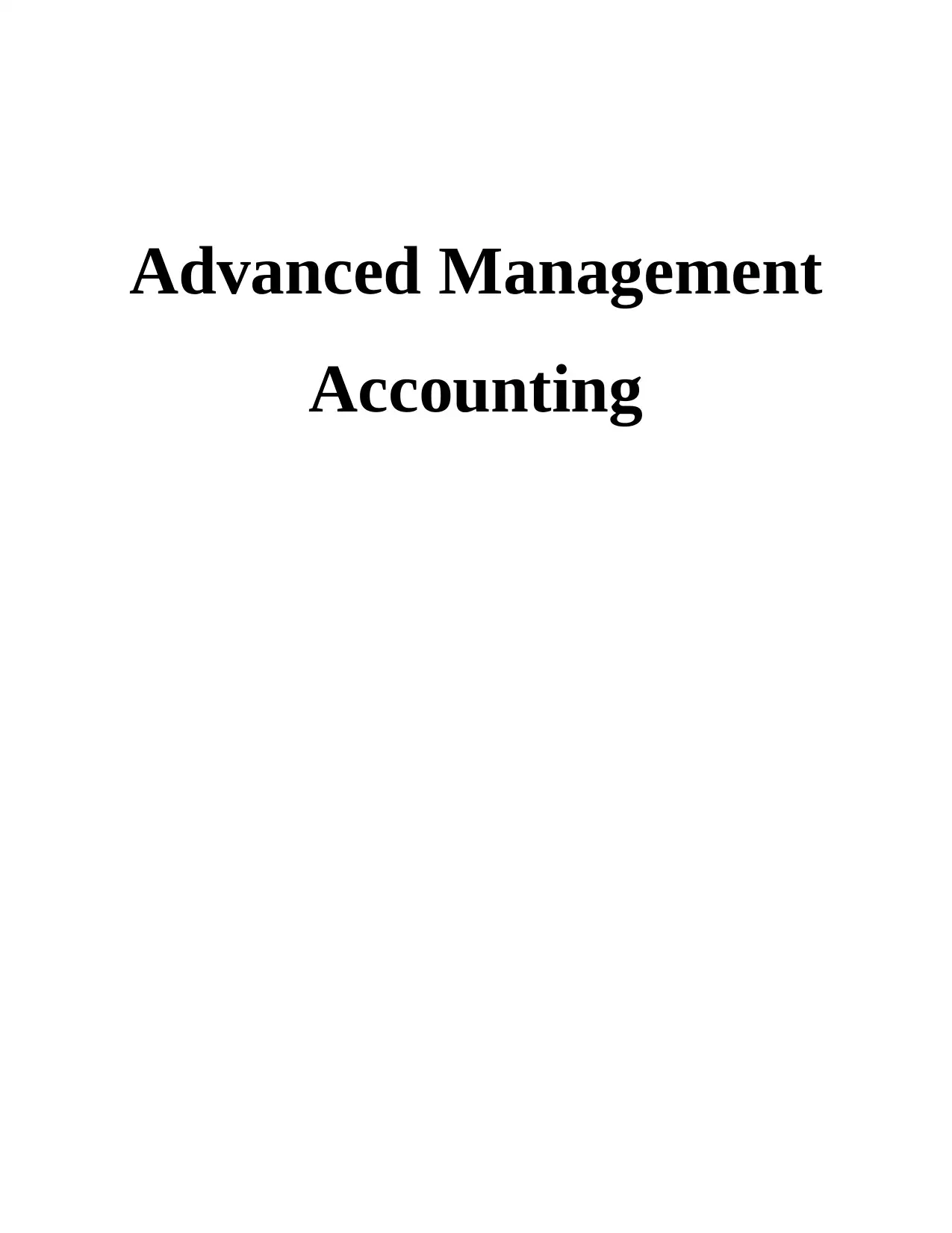
Advanced Management
Accounting
Accounting
Paraphrase This Document
Need a fresh take? Get an instant paraphrase of this document with our AI Paraphraser
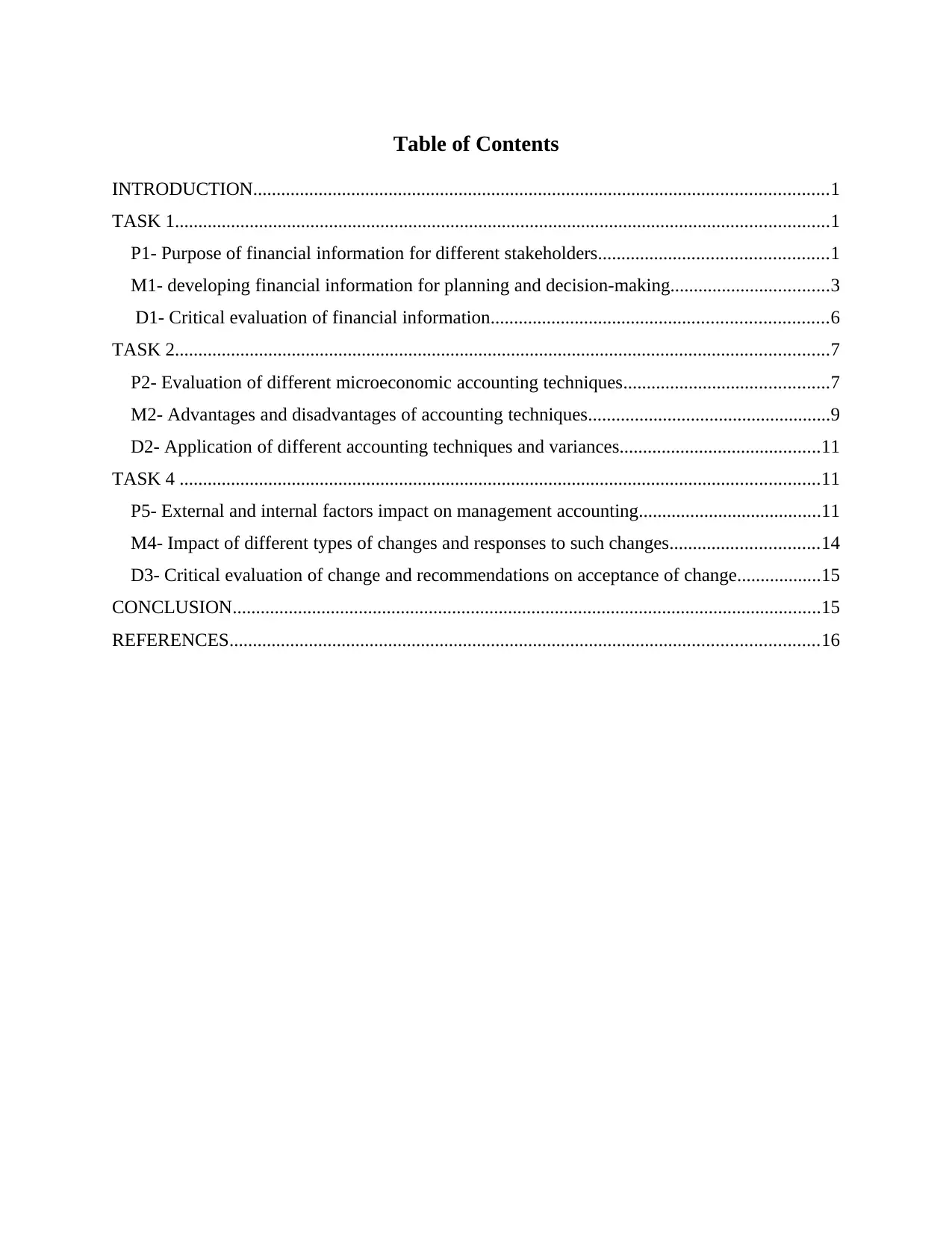
Table of Contents
INTRODUCTION...........................................................................................................................1
TASK 1............................................................................................................................................1
P1- Purpose of financial information for different stakeholders.................................................1
M1- developing financial information for planning and decision-making..................................3
D1- Critical evaluation of financial information........................................................................6
TASK 2............................................................................................................................................7
P2- Evaluation of different microeconomic accounting techniques............................................7
M2- Advantages and disadvantages of accounting techniques....................................................9
D2- Application of different accounting techniques and variances...........................................11
TASK 4 .........................................................................................................................................11
P5- External and internal factors impact on management accounting.......................................11
M4- Impact of different types of changes and responses to such changes................................14
D3- Critical evaluation of change and recommendations on acceptance of change..................15
CONCLUSION..............................................................................................................................15
REFERENCES..............................................................................................................................16
INTRODUCTION...........................................................................................................................1
TASK 1............................................................................................................................................1
P1- Purpose of financial information for different stakeholders.................................................1
M1- developing financial information for planning and decision-making..................................3
D1- Critical evaluation of financial information........................................................................6
TASK 2............................................................................................................................................7
P2- Evaluation of different microeconomic accounting techniques............................................7
M2- Advantages and disadvantages of accounting techniques....................................................9
D2- Application of different accounting techniques and variances...........................................11
TASK 4 .........................................................................................................................................11
P5- External and internal factors impact on management accounting.......................................11
M4- Impact of different types of changes and responses to such changes................................14
D3- Critical evaluation of change and recommendations on acceptance of change..................15
CONCLUSION..............................................................................................................................15
REFERENCES..............................................................................................................................16

⊘ This is a preview!⊘
Do you want full access?
Subscribe today to unlock all pages.

Trusted by 1+ million students worldwide
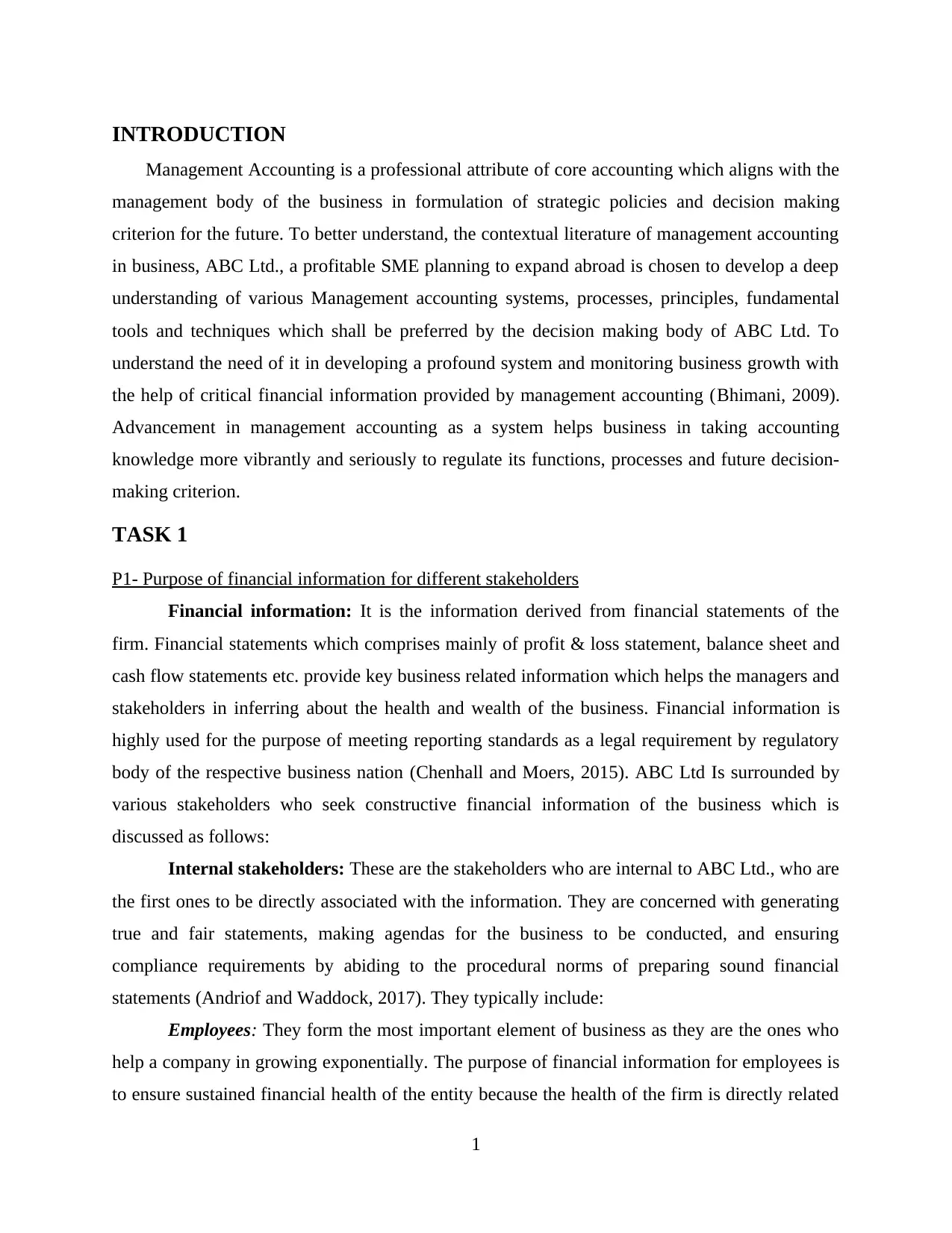
INTRODUCTION
Management Accounting is a professional attribute of core accounting which aligns with the
management body of the business in formulation of strategic policies and decision making
criterion for the future. To better understand, the contextual literature of management accounting
in business, ABC Ltd., a profitable SME planning to expand abroad is chosen to develop a deep
understanding of various Management accounting systems, processes, principles, fundamental
tools and techniques which shall be preferred by the decision making body of ABC Ltd. To
understand the need of it in developing a profound system and monitoring business growth with
the help of critical financial information provided by management accounting (Bhimani, 2009).
Advancement in management accounting as a system helps business in taking accounting
knowledge more vibrantly and seriously to regulate its functions, processes and future decision-
making criterion.
TASK 1
P1- Purpose of financial information for different stakeholders
Financial information: It is the information derived from financial statements of the
firm. Financial statements which comprises mainly of profit & loss statement, balance sheet and
cash flow statements etc. provide key business related information which helps the managers and
stakeholders in inferring about the health and wealth of the business. Financial information is
highly used for the purpose of meeting reporting standards as a legal requirement by regulatory
body of the respective business nation (Chenhall and Moers, 2015). ABC Ltd Is surrounded by
various stakeholders who seek constructive financial information of the business which is
discussed as follows:
Internal stakeholders: These are the stakeholders who are internal to ABC Ltd., who are
the first ones to be directly associated with the information. They are concerned with generating
true and fair statements, making agendas for the business to be conducted, and ensuring
compliance requirements by abiding to the procedural norms of preparing sound financial
statements (Andriof and Waddock, 2017). They typically include:
Employees: They form the most important element of business as they are the ones who
help a company in growing exponentially. The purpose of financial information for employees is
to ensure sustained financial health of the entity because the health of the firm is directly related
1
Management Accounting is a professional attribute of core accounting which aligns with the
management body of the business in formulation of strategic policies and decision making
criterion for the future. To better understand, the contextual literature of management accounting
in business, ABC Ltd., a profitable SME planning to expand abroad is chosen to develop a deep
understanding of various Management accounting systems, processes, principles, fundamental
tools and techniques which shall be preferred by the decision making body of ABC Ltd. To
understand the need of it in developing a profound system and monitoring business growth with
the help of critical financial information provided by management accounting (Bhimani, 2009).
Advancement in management accounting as a system helps business in taking accounting
knowledge more vibrantly and seriously to regulate its functions, processes and future decision-
making criterion.
TASK 1
P1- Purpose of financial information for different stakeholders
Financial information: It is the information derived from financial statements of the
firm. Financial statements which comprises mainly of profit & loss statement, balance sheet and
cash flow statements etc. provide key business related information which helps the managers and
stakeholders in inferring about the health and wealth of the business. Financial information is
highly used for the purpose of meeting reporting standards as a legal requirement by regulatory
body of the respective business nation (Chenhall and Moers, 2015). ABC Ltd Is surrounded by
various stakeholders who seek constructive financial information of the business which is
discussed as follows:
Internal stakeholders: These are the stakeholders who are internal to ABC Ltd., who are
the first ones to be directly associated with the information. They are concerned with generating
true and fair statements, making agendas for the business to be conducted, and ensuring
compliance requirements by abiding to the procedural norms of preparing sound financial
statements (Andriof and Waddock, 2017). They typically include:
Employees: They form the most important element of business as they are the ones who
help a company in growing exponentially. The purpose of financial information for employees is
to ensure sustained financial health of the entity because the health of the firm is directly related
1
Paraphrase This Document
Need a fresh take? Get an instant paraphrase of this document with our AI Paraphraser
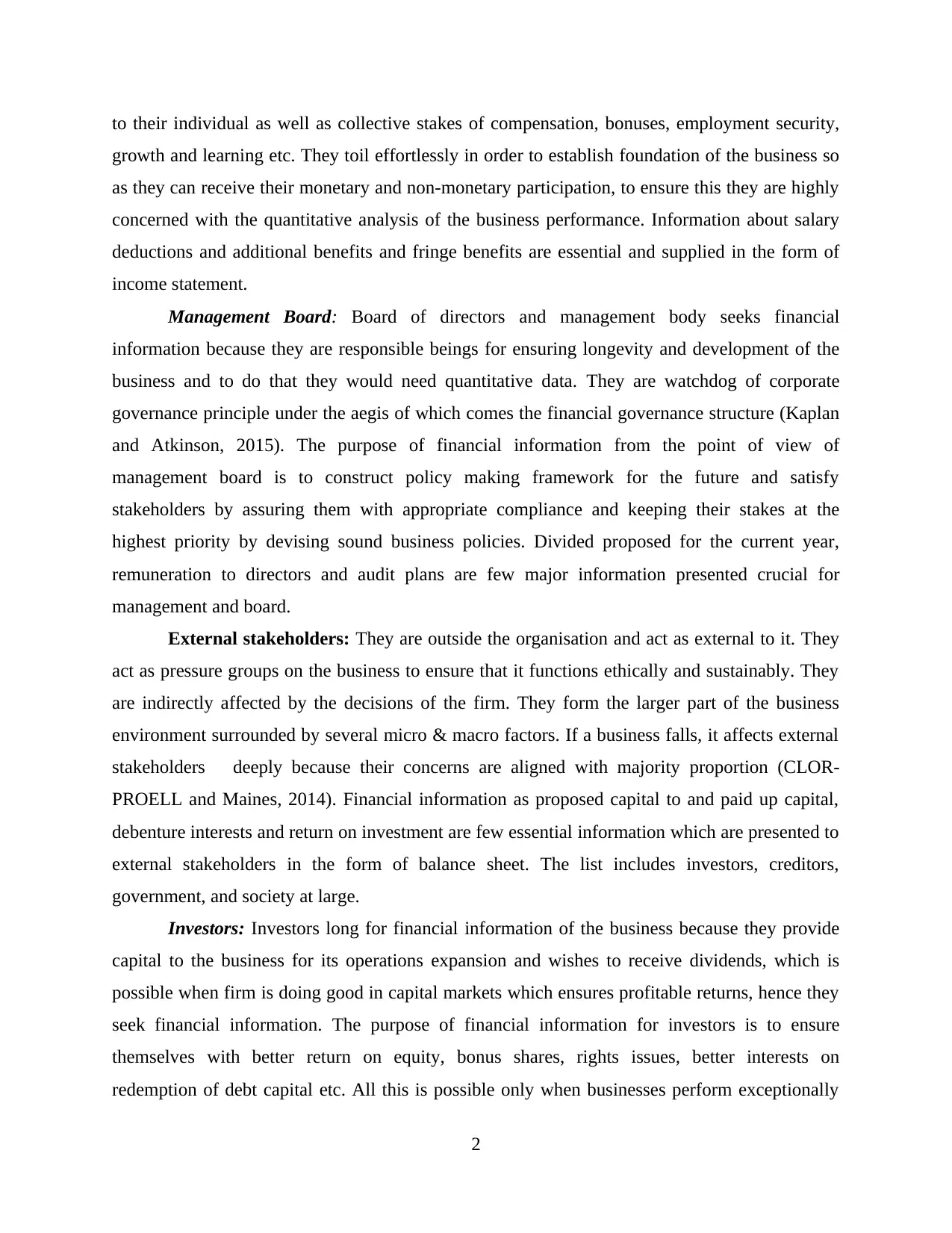
to their individual as well as collective stakes of compensation, bonuses, employment security,
growth and learning etc. They toil effortlessly in order to establish foundation of the business so
as they can receive their monetary and non-monetary participation, to ensure this they are highly
concerned with the quantitative analysis of the business performance. Information about salary
deductions and additional benefits and fringe benefits are essential and supplied in the form of
income statement.
Management Board: Board of directors and management body seeks financial
information because they are responsible beings for ensuring longevity and development of the
business and to do that they would need quantitative data. They are watchdog of corporate
governance principle under the aegis of which comes the financial governance structure (Kaplan
and Atkinson, 2015). The purpose of financial information from the point of view of
management board is to construct policy making framework for the future and satisfy
stakeholders by assuring them with appropriate compliance and keeping their stakes at the
highest priority by devising sound business policies. Divided proposed for the current year,
remuneration to directors and audit plans are few major information presented crucial for
management and board.
External stakeholders: They are outside the organisation and act as external to it. They
act as pressure groups on the business to ensure that it functions ethically and sustainably. They
are indirectly affected by the decisions of the firm. They form the larger part of the business
environment surrounded by several micro & macro factors. If a business falls, it affects external
stakeholders deeply because their concerns are aligned with majority proportion (CLOR‐
PROELL and Maines, 2014). Financial information as proposed capital to and paid up capital,
debenture interests and return on investment are few essential information which are presented to
external stakeholders in the form of balance sheet. The list includes investors, creditors,
government, and society at large.
Investors: Investors long for financial information of the business because they provide
capital to the business for its operations expansion and wishes to receive dividends, which is
possible when firm is doing good in capital markets which ensures profitable returns, hence they
seek financial information. The purpose of financial information for investors is to ensure
themselves with better return on equity, bonus shares, rights issues, better interests on
redemption of debt capital etc. All this is possible only when businesses perform exceptionally
2
growth and learning etc. They toil effortlessly in order to establish foundation of the business so
as they can receive their monetary and non-monetary participation, to ensure this they are highly
concerned with the quantitative analysis of the business performance. Information about salary
deductions and additional benefits and fringe benefits are essential and supplied in the form of
income statement.
Management Board: Board of directors and management body seeks financial
information because they are responsible beings for ensuring longevity and development of the
business and to do that they would need quantitative data. They are watchdog of corporate
governance principle under the aegis of which comes the financial governance structure (Kaplan
and Atkinson, 2015). The purpose of financial information from the point of view of
management board is to construct policy making framework for the future and satisfy
stakeholders by assuring them with appropriate compliance and keeping their stakes at the
highest priority by devising sound business policies. Divided proposed for the current year,
remuneration to directors and audit plans are few major information presented crucial for
management and board.
External stakeholders: They are outside the organisation and act as external to it. They
act as pressure groups on the business to ensure that it functions ethically and sustainably. They
are indirectly affected by the decisions of the firm. They form the larger part of the business
environment surrounded by several micro & macro factors. If a business falls, it affects external
stakeholders deeply because their concerns are aligned with majority proportion (CLOR‐
PROELL and Maines, 2014). Financial information as proposed capital to and paid up capital,
debenture interests and return on investment are few essential information which are presented to
external stakeholders in the form of balance sheet. The list includes investors, creditors,
government, and society at large.
Investors: Investors long for financial information of the business because they provide
capital to the business for its operations expansion and wishes to receive dividends, which is
possible when firm is doing good in capital markets which ensures profitable returns, hence they
seek financial information. The purpose of financial information for investors is to ensure
themselves with better return on equity, bonus shares, rights issues, better interests on
redemption of debt capital etc. All this is possible only when businesses perform exceptionally
2
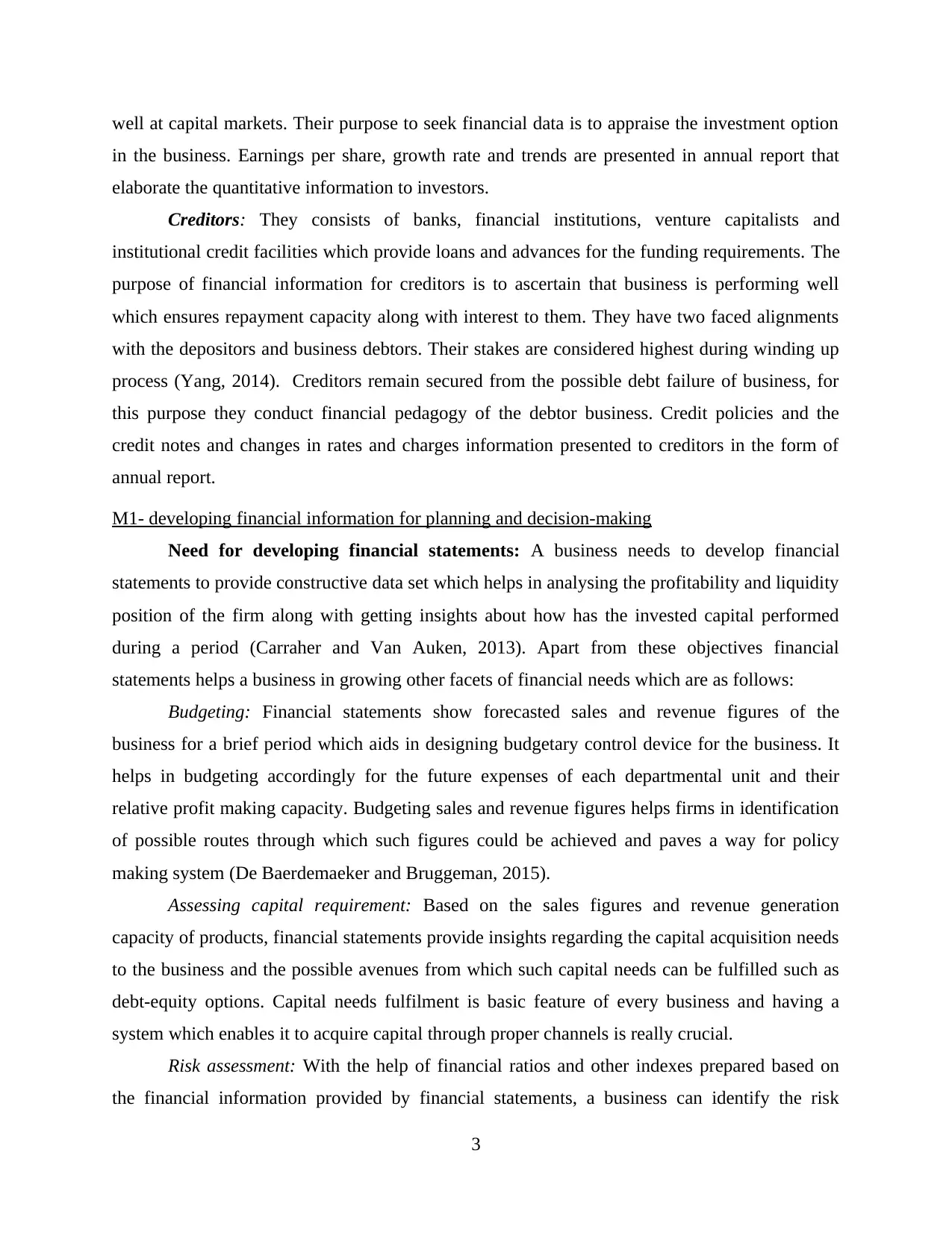
well at capital markets. Their purpose to seek financial data is to appraise the investment option
in the business. Earnings per share, growth rate and trends are presented in annual report that
elaborate the quantitative information to investors.
Creditors: They consists of banks, financial institutions, venture capitalists and
institutional credit facilities which provide loans and advances for the funding requirements. The
purpose of financial information for creditors is to ascertain that business is performing well
which ensures repayment capacity along with interest to them. They have two faced alignments
with the depositors and business debtors. Their stakes are considered highest during winding up
process (Yang, 2014). Creditors remain secured from the possible debt failure of business, for
this purpose they conduct financial pedagogy of the debtor business. Credit policies and the
credit notes and changes in rates and charges information presented to creditors in the form of
annual report.
M1- developing financial information for planning and decision-making
Need for developing financial statements: A business needs to develop financial
statements to provide constructive data set which helps in analysing the profitability and liquidity
position of the firm along with getting insights about how has the invested capital performed
during a period (Carraher and Van Auken, 2013). Apart from these objectives financial
statements helps a business in growing other facets of financial needs which are as follows:
Budgeting: Financial statements show forecasted sales and revenue figures of the
business for a brief period which aids in designing budgetary control device for the business. It
helps in budgeting accordingly for the future expenses of each departmental unit and their
relative profit making capacity. Budgeting sales and revenue figures helps firms in identification
of possible routes through which such figures could be achieved and paves a way for policy
making system (De Baerdemaeker and Bruggeman, 2015).
Assessing capital requirement: Based on the sales figures and revenue generation
capacity of products, financial statements provide insights regarding the capital acquisition needs
to the business and the possible avenues from which such capital needs can be fulfilled such as
debt-equity options. Capital needs fulfilment is basic feature of every business and having a
system which enables it to acquire capital through proper channels is really crucial.
Risk assessment: With the help of financial ratios and other indexes prepared based on
the financial information provided by financial statements, a business can identify the risk
3
in the business. Earnings per share, growth rate and trends are presented in annual report that
elaborate the quantitative information to investors.
Creditors: They consists of banks, financial institutions, venture capitalists and
institutional credit facilities which provide loans and advances for the funding requirements. The
purpose of financial information for creditors is to ascertain that business is performing well
which ensures repayment capacity along with interest to them. They have two faced alignments
with the depositors and business debtors. Their stakes are considered highest during winding up
process (Yang, 2014). Creditors remain secured from the possible debt failure of business, for
this purpose they conduct financial pedagogy of the debtor business. Credit policies and the
credit notes and changes in rates and charges information presented to creditors in the form of
annual report.
M1- developing financial information for planning and decision-making
Need for developing financial statements: A business needs to develop financial
statements to provide constructive data set which helps in analysing the profitability and liquidity
position of the firm along with getting insights about how has the invested capital performed
during a period (Carraher and Van Auken, 2013). Apart from these objectives financial
statements helps a business in growing other facets of financial needs which are as follows:
Budgeting: Financial statements show forecasted sales and revenue figures of the
business for a brief period which aids in designing budgetary control device for the business. It
helps in budgeting accordingly for the future expenses of each departmental unit and their
relative profit making capacity. Budgeting sales and revenue figures helps firms in identification
of possible routes through which such figures could be achieved and paves a way for policy
making system (De Baerdemaeker and Bruggeman, 2015).
Assessing capital requirement: Based on the sales figures and revenue generation
capacity of products, financial statements provide insights regarding the capital acquisition needs
to the business and the possible avenues from which such capital needs can be fulfilled such as
debt-equity options. Capital needs fulfilment is basic feature of every business and having a
system which enables it to acquire capital through proper channels is really crucial.
Risk assessment: With the help of financial ratios and other indexes prepared based on
the financial information provided by financial statements, a business can identify the risk
3
⊘ This is a preview!⊘
Do you want full access?
Subscribe today to unlock all pages.

Trusted by 1+ million students worldwide
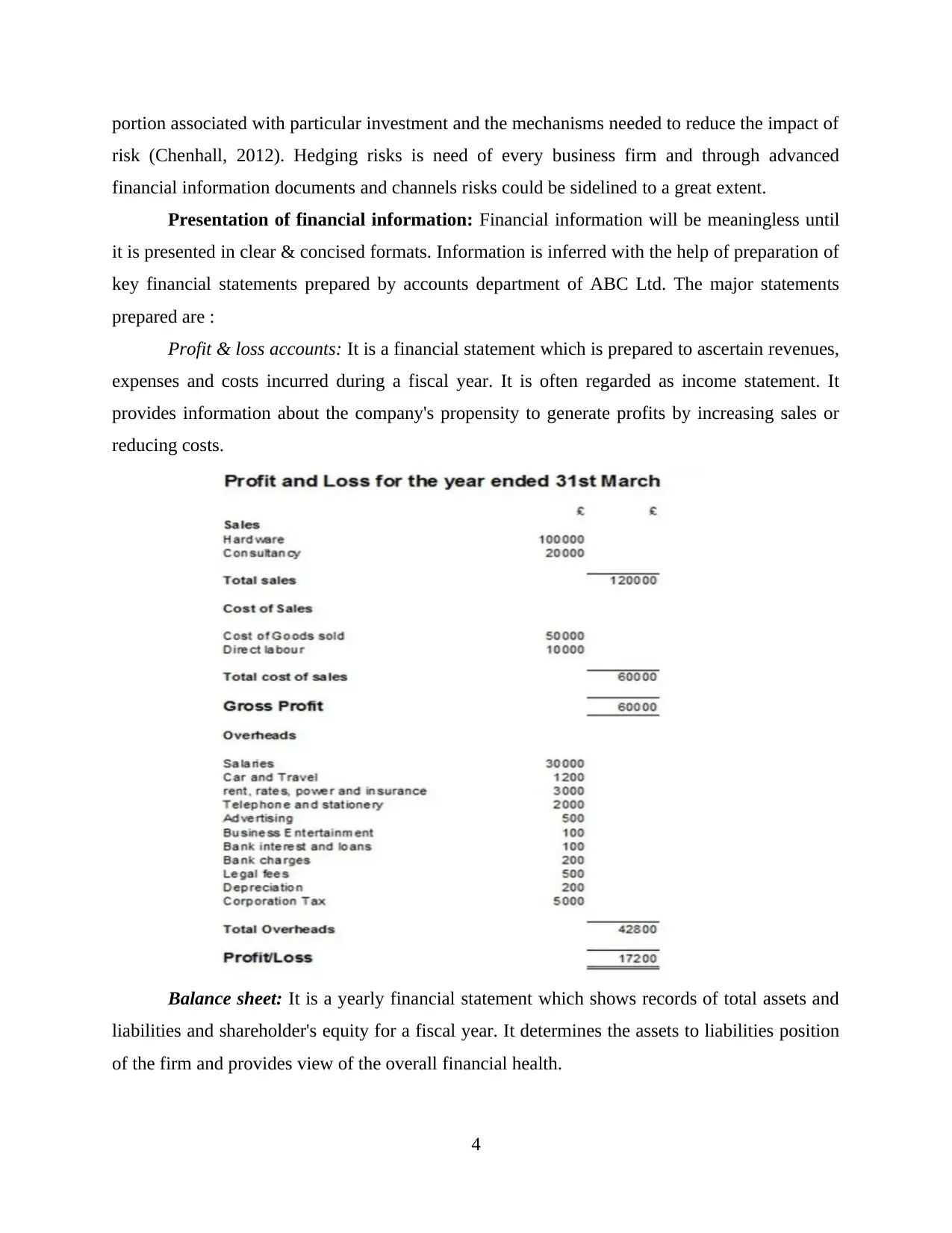
portion associated with particular investment and the mechanisms needed to reduce the impact of
risk (Chenhall, 2012). Hedging risks is need of every business firm and through advanced
financial information documents and channels risks could be sidelined to a great extent.
Presentation of financial information: Financial information will be meaningless until
it is presented in clear & concised formats. Information is inferred with the help of preparation of
key financial statements prepared by accounts department of ABC Ltd. The major statements
prepared are :
Profit & loss accounts: It is a financial statement which is prepared to ascertain revenues,
expenses and costs incurred during a fiscal year. It is often regarded as income statement. It
provides information about the company's propensity to generate profits by increasing sales or
reducing costs.
Balance sheet: It is a yearly financial statement which shows records of total assets and
liabilities and shareholder's equity for a fiscal year. It determines the assets to liabilities position
of the firm and provides view of the overall financial health.
4
risk (Chenhall, 2012). Hedging risks is need of every business firm and through advanced
financial information documents and channels risks could be sidelined to a great extent.
Presentation of financial information: Financial information will be meaningless until
it is presented in clear & concised formats. Information is inferred with the help of preparation of
key financial statements prepared by accounts department of ABC Ltd. The major statements
prepared are :
Profit & loss accounts: It is a financial statement which is prepared to ascertain revenues,
expenses and costs incurred during a fiscal year. It is often regarded as income statement. It
provides information about the company's propensity to generate profits by increasing sales or
reducing costs.
Balance sheet: It is a yearly financial statement which shows records of total assets and
liabilities and shareholder's equity for a fiscal year. It determines the assets to liabilities position
of the firm and provides view of the overall financial health.
4
Paraphrase This Document
Need a fresh take? Get an instant paraphrase of this document with our AI Paraphraser
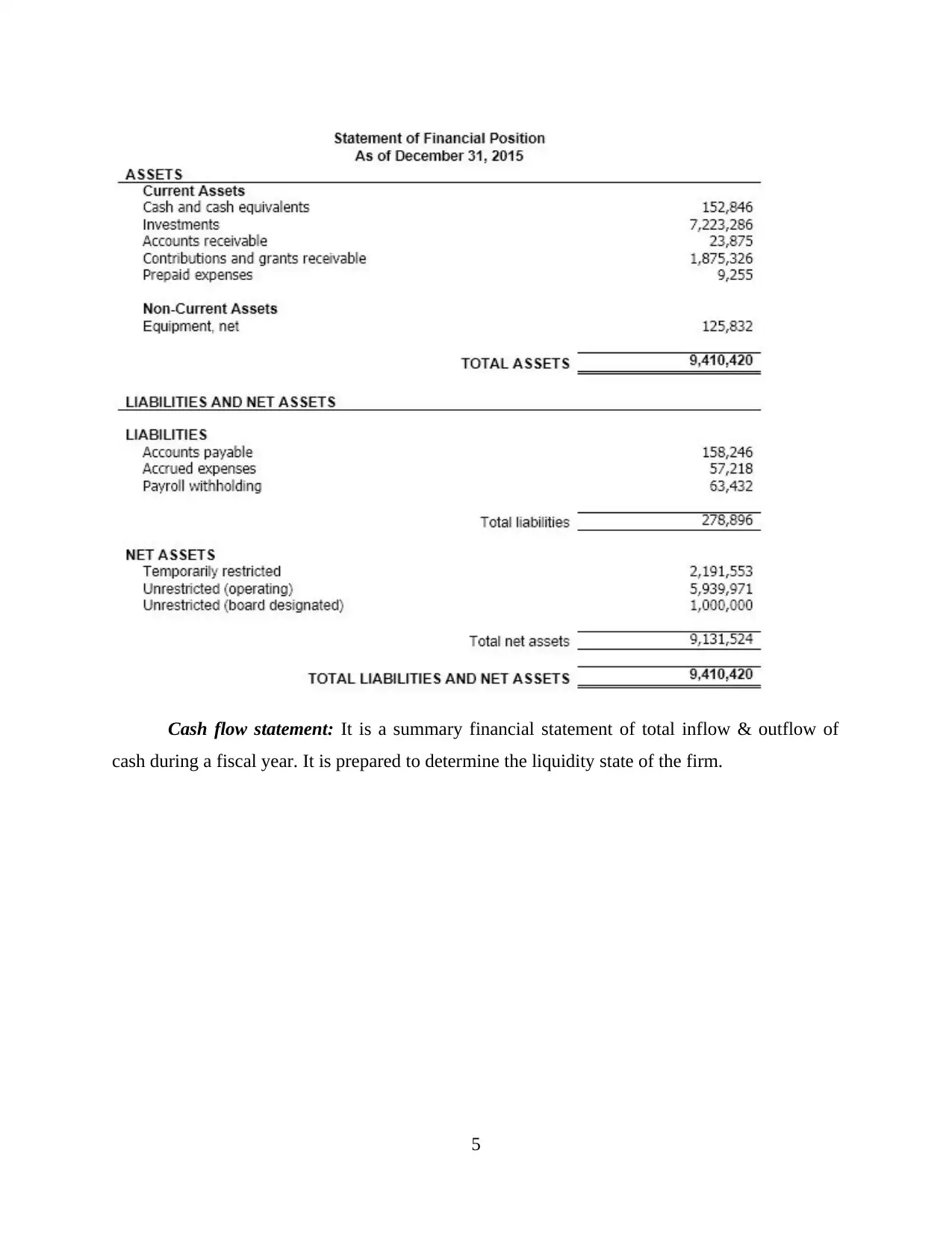
Cash flow statement: It is a summary financial statement of total inflow & outflow of
cash during a fiscal year. It is prepared to determine the liquidity state of the firm.
5
cash during a fiscal year. It is prepared to determine the liquidity state of the firm.
5
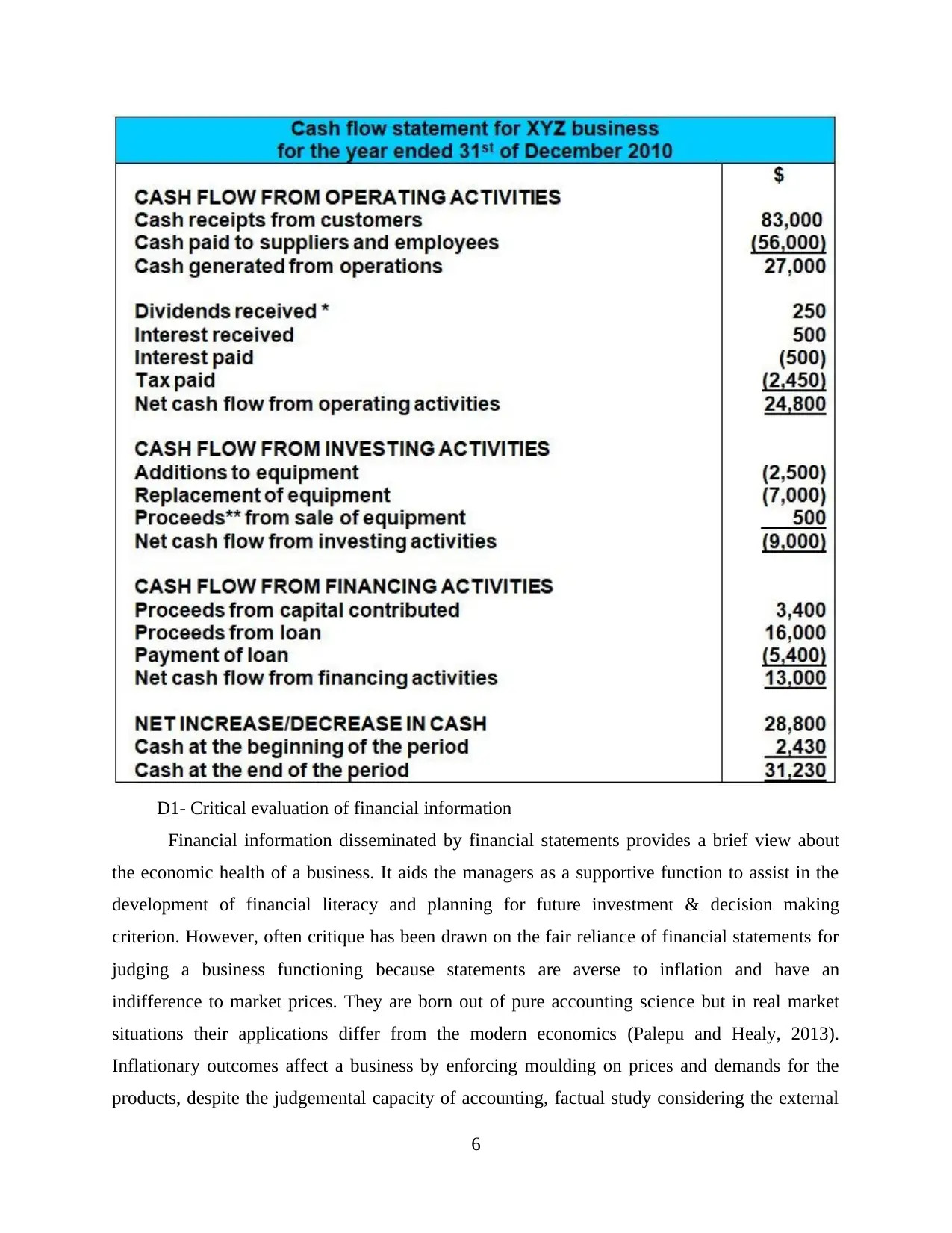
D1- Critical evaluation of financial information
Financial information disseminated by financial statements provides a brief view about
the economic health of a business. It aids the managers as a supportive function to assist in the
development of financial literacy and planning for future investment & decision making
criterion. However, often critique has been drawn on the fair reliance of financial statements for
judging a business functioning because statements are averse to inflation and have an
indifference to market prices. They are born out of pure accounting science but in real market
situations their applications differ from the modern economics (Palepu and Healy, 2013).
Inflationary outcomes affect a business by enforcing moulding on prices and demands for the
products, despite the judgemental capacity of accounting, factual study considering the external
6
Financial information disseminated by financial statements provides a brief view about
the economic health of a business. It aids the managers as a supportive function to assist in the
development of financial literacy and planning for future investment & decision making
criterion. However, often critique has been drawn on the fair reliance of financial statements for
judging a business functioning because statements are averse to inflation and have an
indifference to market prices. They are born out of pure accounting science but in real market
situations their applications differ from the modern economics (Palepu and Healy, 2013).
Inflationary outcomes affect a business by enforcing moulding on prices and demands for the
products, despite the judgemental capacity of accounting, factual study considering the external
6
⊘ This is a preview!⊘
Do you want full access?
Subscribe today to unlock all pages.

Trusted by 1+ million students worldwide
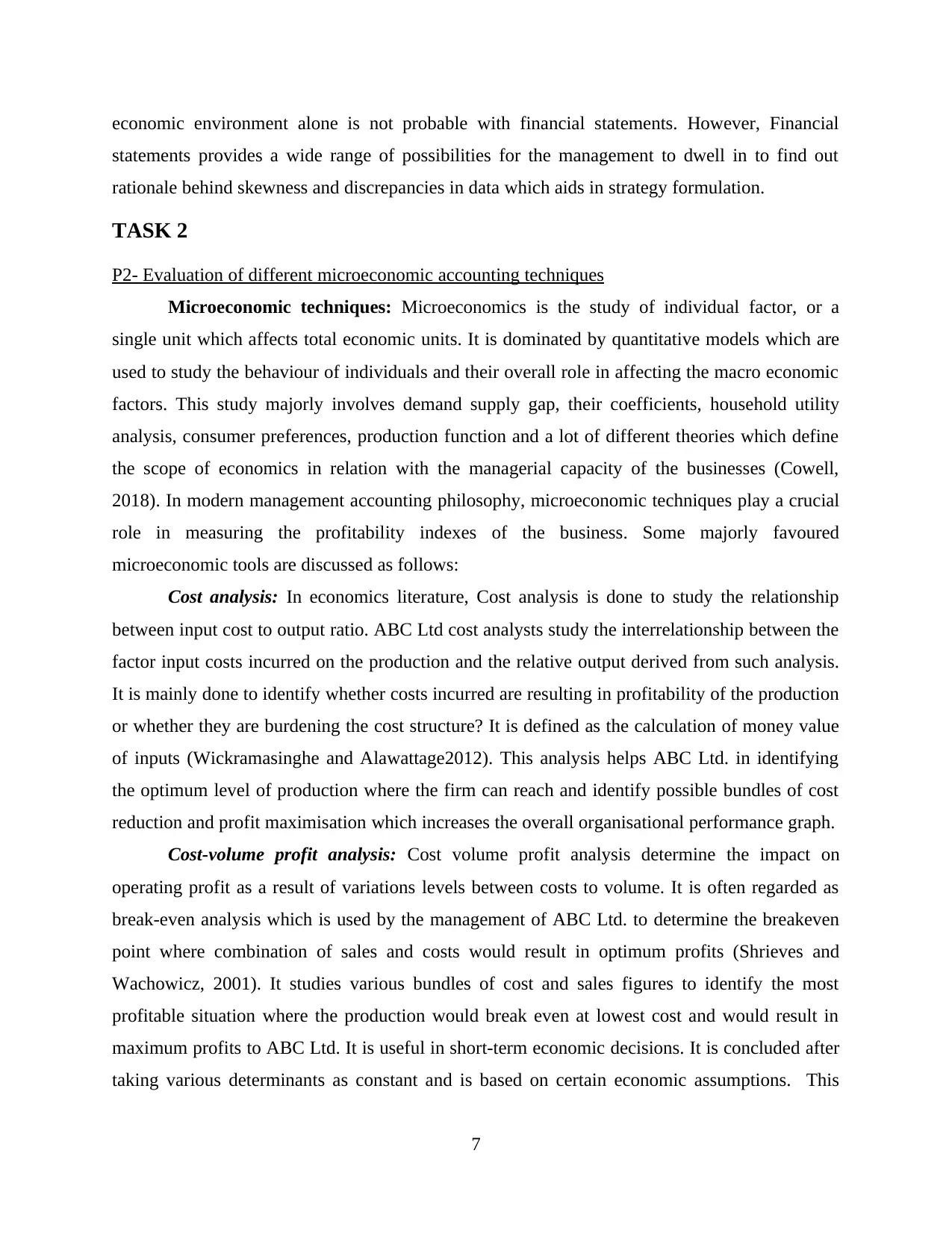
economic environment alone is not probable with financial statements. However, Financial
statements provides a wide range of possibilities for the management to dwell in to find out
rationale behind skewness and discrepancies in data which aids in strategy formulation.
TASK 2
P2- Evaluation of different microeconomic accounting techniques
Microeconomic techniques: Microeconomics is the study of individual factor, or a
single unit which affects total economic units. It is dominated by quantitative models which are
used to study the behaviour of individuals and their overall role in affecting the macro economic
factors. This study majorly involves demand supply gap, their coefficients, household utility
analysis, consumer preferences, production function and a lot of different theories which define
the scope of economics in relation with the managerial capacity of the businesses (Cowell,
2018). In modern management accounting philosophy, microeconomic techniques play a crucial
role in measuring the profitability indexes of the business. Some majorly favoured
microeconomic tools are discussed as follows:
Cost analysis: In economics literature, Cost analysis is done to study the relationship
between input cost to output ratio. ABC Ltd cost analysts study the interrelationship between the
factor input costs incurred on the production and the relative output derived from such analysis.
It is mainly done to identify whether costs incurred are resulting in profitability of the production
or whether they are burdening the cost structure? It is defined as the calculation of money value
of inputs (Wickramasinghe and Alawattage2012). This analysis helps ABC Ltd. in identifying
the optimum level of production where the firm can reach and identify possible bundles of cost
reduction and profit maximisation which increases the overall organisational performance graph.
Cost-volume profit analysis: Cost volume profit analysis determine the impact on
operating profit as a result of variations levels between costs to volume. It is often regarded as
break-even analysis which is used by the management of ABC Ltd. to determine the breakeven
point where combination of sales and costs would result in optimum profits (Shrieves and
Wachowicz, 2001). It studies various bundles of cost and sales figures to identify the most
profitable situation where the production would break even at lowest cost and would result in
maximum profits to ABC Ltd. It is useful in short-term economic decisions. It is concluded after
taking various determinants as constant and is based on certain economic assumptions. This
7
statements provides a wide range of possibilities for the management to dwell in to find out
rationale behind skewness and discrepancies in data which aids in strategy formulation.
TASK 2
P2- Evaluation of different microeconomic accounting techniques
Microeconomic techniques: Microeconomics is the study of individual factor, or a
single unit which affects total economic units. It is dominated by quantitative models which are
used to study the behaviour of individuals and their overall role in affecting the macro economic
factors. This study majorly involves demand supply gap, their coefficients, household utility
analysis, consumer preferences, production function and a lot of different theories which define
the scope of economics in relation with the managerial capacity of the businesses (Cowell,
2018). In modern management accounting philosophy, microeconomic techniques play a crucial
role in measuring the profitability indexes of the business. Some majorly favoured
microeconomic tools are discussed as follows:
Cost analysis: In economics literature, Cost analysis is done to study the relationship
between input cost to output ratio. ABC Ltd cost analysts study the interrelationship between the
factor input costs incurred on the production and the relative output derived from such analysis.
It is mainly done to identify whether costs incurred are resulting in profitability of the production
or whether they are burdening the cost structure? It is defined as the calculation of money value
of inputs (Wickramasinghe and Alawattage2012). This analysis helps ABC Ltd. in identifying
the optimum level of production where the firm can reach and identify possible bundles of cost
reduction and profit maximisation which increases the overall organisational performance graph.
Cost-volume profit analysis: Cost volume profit analysis determine the impact on
operating profit as a result of variations levels between costs to volume. It is often regarded as
break-even analysis which is used by the management of ABC Ltd. to determine the breakeven
point where combination of sales and costs would result in optimum profits (Shrieves and
Wachowicz, 2001). It studies various bundles of cost and sales figures to identify the most
profitable situation where the production would break even at lowest cost and would result in
maximum profits to ABC Ltd. It is useful in short-term economic decisions. It is concluded after
taking various determinants as constant and is based on certain economic assumptions. This
7
Paraphrase This Document
Need a fresh take? Get an instant paraphrase of this document with our AI Paraphraser
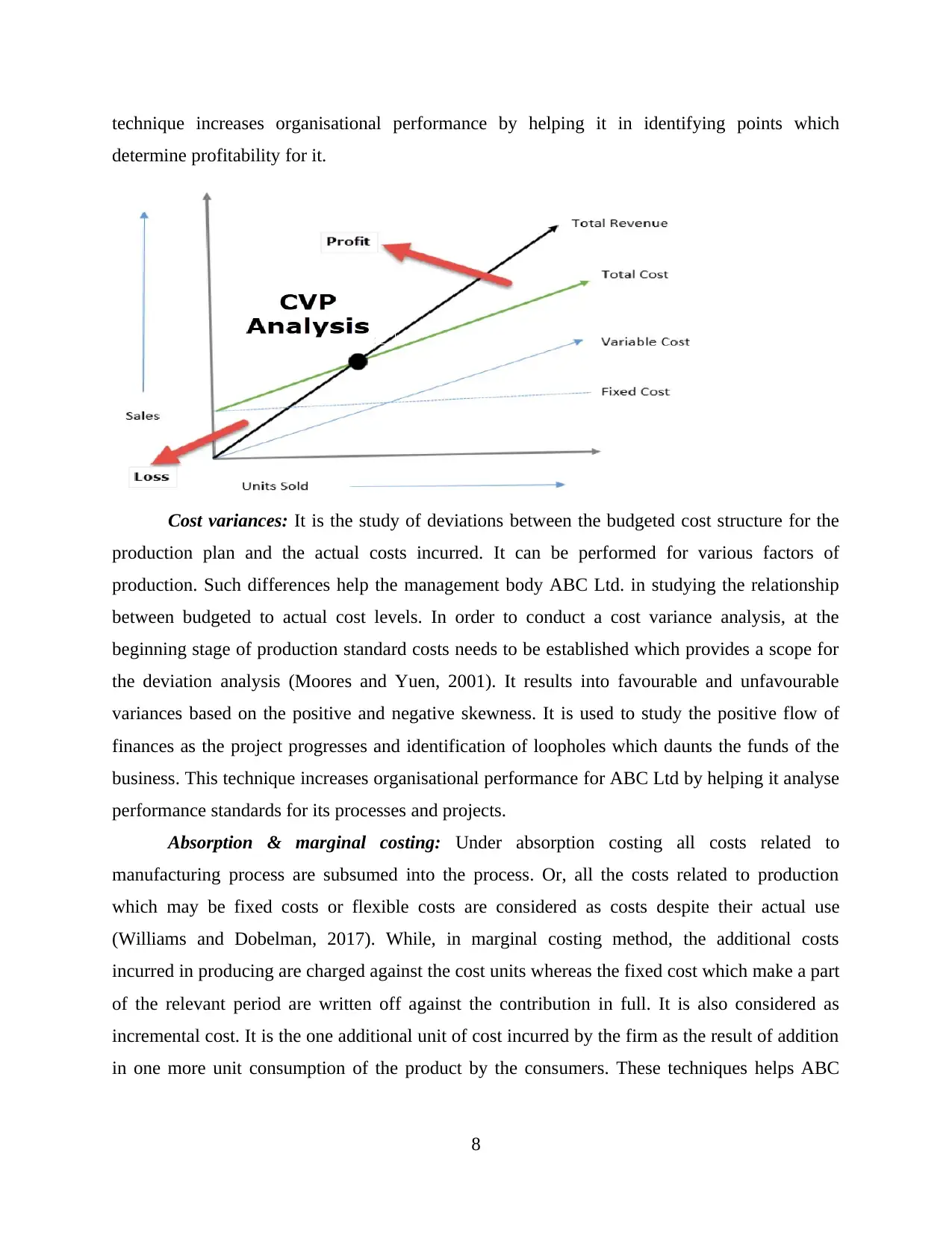
technique increases organisational performance by helping it in identifying points which
determine profitability for it.
Cost variances: It is the study of deviations between the budgeted cost structure for the
production plan and the actual costs incurred. It can be performed for various factors of
production. Such differences help the management body ABC Ltd. in studying the relationship
between budgeted to actual cost levels. In order to conduct a cost variance analysis, at the
beginning stage of production standard costs needs to be established which provides a scope for
the deviation analysis (Moores and Yuen, 2001). It results into favourable and unfavourable
variances based on the positive and negative skewness. It is used to study the positive flow of
finances as the project progresses and identification of loopholes which daunts the funds of the
business. This technique increases organisational performance for ABC Ltd by helping it analyse
performance standards for its processes and projects.
Absorption & marginal costing: Under absorption costing all costs related to
manufacturing process are subsumed into the process. Or, all the costs related to production
which may be fixed costs or flexible costs are considered as costs despite their actual use
(Williams and Dobelman, 2017). While, in marginal costing method, the additional costs
incurred in producing are charged against the cost units whereas the fixed cost which make a part
of the relevant period are written off against the contribution in full. It is also considered as
incremental cost. It is the one additional unit of cost incurred by the firm as the result of addition
in one more unit consumption of the product by the consumers. These techniques helps ABC
8
determine profitability for it.
Cost variances: It is the study of deviations between the budgeted cost structure for the
production plan and the actual costs incurred. It can be performed for various factors of
production. Such differences help the management body ABC Ltd. in studying the relationship
between budgeted to actual cost levels. In order to conduct a cost variance analysis, at the
beginning stage of production standard costs needs to be established which provides a scope for
the deviation analysis (Moores and Yuen, 2001). It results into favourable and unfavourable
variances based on the positive and negative skewness. It is used to study the positive flow of
finances as the project progresses and identification of loopholes which daunts the funds of the
business. This technique increases organisational performance for ABC Ltd by helping it analyse
performance standards for its processes and projects.
Absorption & marginal costing: Under absorption costing all costs related to
manufacturing process are subsumed into the process. Or, all the costs related to production
which may be fixed costs or flexible costs are considered as costs despite their actual use
(Williams and Dobelman, 2017). While, in marginal costing method, the additional costs
incurred in producing are charged against the cost units whereas the fixed cost which make a part
of the relevant period are written off against the contribution in full. It is also considered as
incremental cost. It is the one additional unit of cost incurred by the firm as the result of addition
in one more unit consumption of the product by the consumers. These techniques helps ABC
8
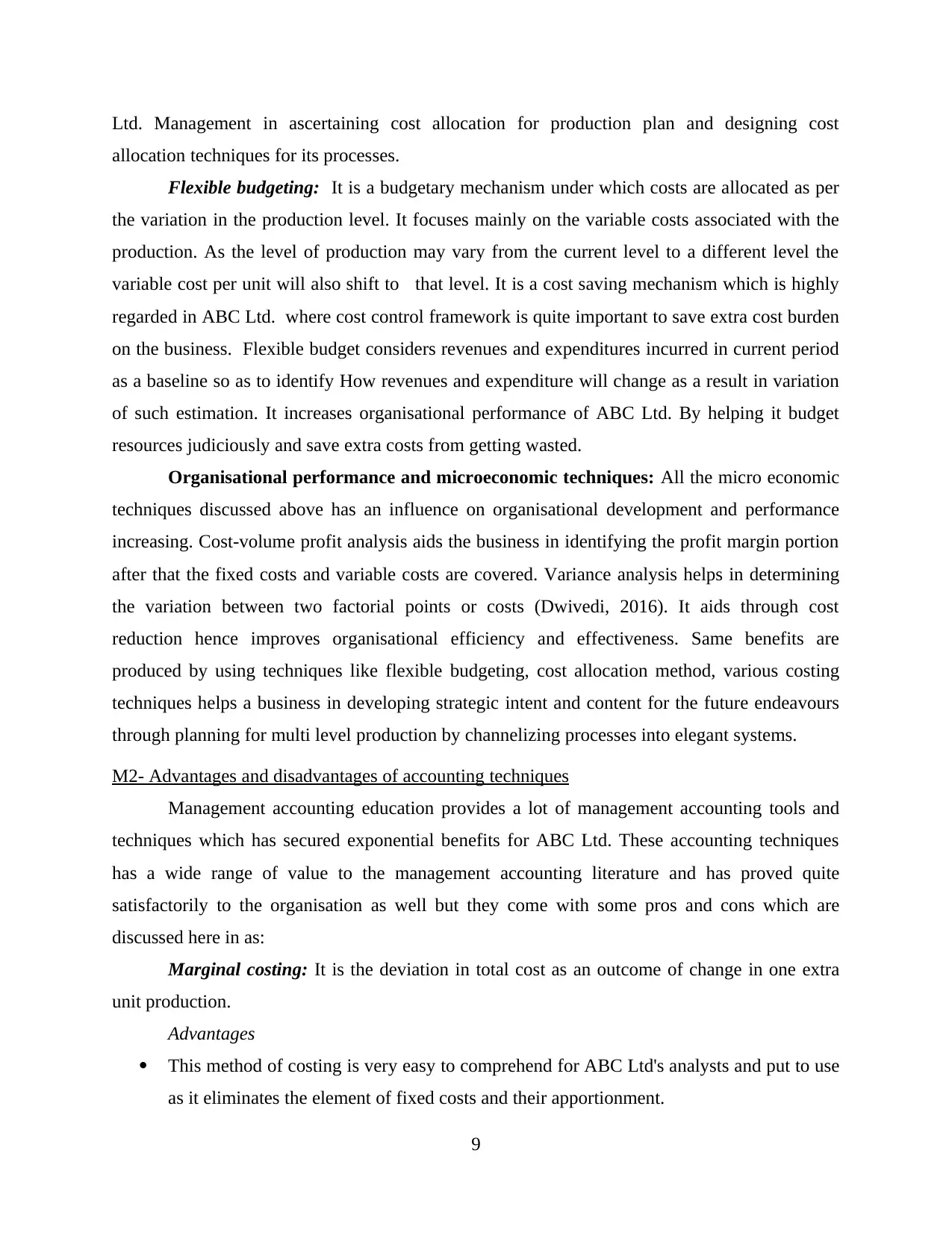
Ltd. Management in ascertaining cost allocation for production plan and designing cost
allocation techniques for its processes.
Flexible budgeting: It is a budgetary mechanism under which costs are allocated as per
the variation in the production level. It focuses mainly on the variable costs associated with the
production. As the level of production may vary from the current level to a different level the
variable cost per unit will also shift to that level. It is a cost saving mechanism which is highly
regarded in ABC Ltd. where cost control framework is quite important to save extra cost burden
on the business. Flexible budget considers revenues and expenditures incurred in current period
as a baseline so as to identify How revenues and expenditure will change as a result in variation
of such estimation. It increases organisational performance of ABC Ltd. By helping it budget
resources judiciously and save extra costs from getting wasted.
Organisational performance and microeconomic techniques: All the micro economic
techniques discussed above has an influence on organisational development and performance
increasing. Cost-volume profit analysis aids the business in identifying the profit margin portion
after that the fixed costs and variable costs are covered. Variance analysis helps in determining
the variation between two factorial points or costs (Dwivedi, 2016). It aids through cost
reduction hence improves organisational efficiency and effectiveness. Same benefits are
produced by using techniques like flexible budgeting, cost allocation method, various costing
techniques helps a business in developing strategic intent and content for the future endeavours
through planning for multi level production by channelizing processes into elegant systems.
M2- Advantages and disadvantages of accounting techniques
Management accounting education provides a lot of management accounting tools and
techniques which has secured exponential benefits for ABC Ltd. These accounting techniques
has a wide range of value to the management accounting literature and has proved quite
satisfactorily to the organisation as well but they come with some pros and cons which are
discussed here in as:
Marginal costing: It is the deviation in total cost as an outcome of change in one extra
unit production.
Advantages
This method of costing is very easy to comprehend for ABC Ltd's analysts and put to use
as it eliminates the element of fixed costs and their apportionment.
9
allocation techniques for its processes.
Flexible budgeting: It is a budgetary mechanism under which costs are allocated as per
the variation in the production level. It focuses mainly on the variable costs associated with the
production. As the level of production may vary from the current level to a different level the
variable cost per unit will also shift to that level. It is a cost saving mechanism which is highly
regarded in ABC Ltd. where cost control framework is quite important to save extra cost burden
on the business. Flexible budget considers revenues and expenditures incurred in current period
as a baseline so as to identify How revenues and expenditure will change as a result in variation
of such estimation. It increases organisational performance of ABC Ltd. By helping it budget
resources judiciously and save extra costs from getting wasted.
Organisational performance and microeconomic techniques: All the micro economic
techniques discussed above has an influence on organisational development and performance
increasing. Cost-volume profit analysis aids the business in identifying the profit margin portion
after that the fixed costs and variable costs are covered. Variance analysis helps in determining
the variation between two factorial points or costs (Dwivedi, 2016). It aids through cost
reduction hence improves organisational efficiency and effectiveness. Same benefits are
produced by using techniques like flexible budgeting, cost allocation method, various costing
techniques helps a business in developing strategic intent and content for the future endeavours
through planning for multi level production by channelizing processes into elegant systems.
M2- Advantages and disadvantages of accounting techniques
Management accounting education provides a lot of management accounting tools and
techniques which has secured exponential benefits for ABC Ltd. These accounting techniques
has a wide range of value to the management accounting literature and has proved quite
satisfactorily to the organisation as well but they come with some pros and cons which are
discussed here in as:
Marginal costing: It is the deviation in total cost as an outcome of change in one extra
unit production.
Advantages
This method of costing is very easy to comprehend for ABC Ltd's analysts and put to use
as it eliminates the element of fixed costs and their apportionment.
9
⊘ This is a preview!⊘
Do you want full access?
Subscribe today to unlock all pages.

Trusted by 1+ million students worldwide
1 out of 20
Related Documents
Your All-in-One AI-Powered Toolkit for Academic Success.
+13062052269
info@desklib.com
Available 24*7 on WhatsApp / Email
![[object Object]](/_next/static/media/star-bottom.7253800d.svg)
Unlock your academic potential
Copyright © 2020–2025 A2Z Services. All Rights Reserved. Developed and managed by ZUCOL.





